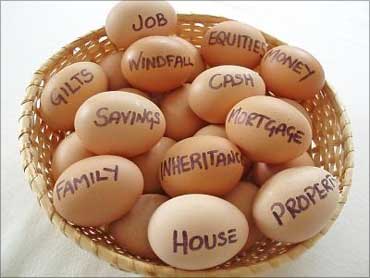
The markets have been volatile for some time. It is difficult to predict the movements. Experts term these short-term corrections, which should not affect your investments, advised to be for the long term.
But, what should one do when markets dip to very low levels? For instance, when markets fell in 2008, huge capital gains were wiped out in a very short period of time.
Therefore, experts advise hedging your portfolio. Hedging is minimising risk, as well as gaining on it. Depending on the type of portfolio (equity, real estate, etc), hedging should be done by investing in such asset class which is inversely proportional to the asset class your portfolio comprises of, typically.
For instance, if you have an equity portfolio, gold can be a good hedging avenue because gold prices are inversely co-related to equity market movements, in general.
There are different instruments which help in hedging the portfolio. Here's some help.
Click on NEXT to read more...

Futures & Options
These are derivative instruments which derive value from the underlying assets like stocks, bonds, indices, commodities or currencies. The best part is that these are liquid options.
A futures contract is agreed to be bought at a future date, with the price and terms set today. You hedge yourself from the risk of higher price of the underlying asset class in the coming days.
An option is a contract that gives the holder the right (not the obligation) to buy or sell a security on or before a particular date. It is a contract between two parties, wherein the buyer gets a privilege for paying a premium (fee) and the seller accepts an obligation for the fee.
In uncertain times, if an investor doesn't want to speculate, futures is a good alternative to minimise exposure to markets by selling the contract and hedging. Still, experts say hedging may not always help make money here. Say, the index moves up instead of going down: a futures position will incur loss and the investor has to fund it.
Therefore, investors should adopt this strategy for a short period of time. The best futures does is help get rid of unwanted exposure.
The other requirement here is margin money, the minimum prescribed amount paid to the broker as security. It varies from 10-25 per cent, from broker to broker.
Anil Rego, CEO, Right Horizons, said: "In many cases, premiums for options could be very high (as much as 20 per cent) and could eat into your returns." And, if your call goes wrong, the difference has to be paid. Suppose the Nifty contract falls to 5,000 points from 5,200. The investor will have to pay Rs 10,000 (200x50).
However, experts advise against derivatives, as it is mostly used to speculate and trade. High net worth individuals with extra cash in hand can indulge in this avenue, as it is not meant for investment but for trading.
Click on NEXT to read more...

Gold
Traditionally, gold and stock markets are known to be inversely co-related. So, too, with gold and currencies and/or bonds. Hence, gold is called a hedging instrument.
However, last year, both markets and gold were strengthening together. Similarly, when the dollar was falling in early 2009, gold prices were almost stable, only to reverse when the currency strengthened later. Though, the recent rally in gold was seen on the back of a declining euro.
Due to gold's intrinsic value, it is considered a safe and liquid option in volatile market conditions. Experts say extra cash can be kept in the form of gold. For retail investors, gold exchange traded funds (ETFs) are a good form of buying gold, as compared to physical gold.
According to Value Research, a mutual fund rating agency, gold ETFs have returned over 27 per cent in the past year, as against 10 per cent from the Sensex.
Click on NEXT to read more...

Debt
The best known option to hedge your portfolio. Holding debt in your portfolio always saves you from any kind of market downslide. Though debt gives low returns,it helps by cushioning adverse market movements.
Financial advisors say the type of debt instrument can vary according to the investor's risk appetite. For instance, bank fixed deposits are meant for extremely conservative investors.
Medium-risk debt investors can look at liquid funds, which offer better rates (4-5 per cent) than savings account (3.5 per cent) and give tax benefits, too. Higher risk-taking debt investors may opt for debt-oriented hybrid funds (returned 10 per cent in one year) and monthly income plans (MIPs, returned seven per cent in one year).
Click on NEXT to read more...

Diversification
This is the simplest way of hedging your portfolio. Balakrishnan Venkatramani, a certified financial planner said, "Diversifying for hedging, both in the same asset class or different asset classes, helps save a lot of money."
If you have an all-equity portfolio you can diversify between large-, mid- and small-cap stocks or funds. Similarly, if you are risk-averse, you may diversify between different types of debt instruments, with varying risk levels.